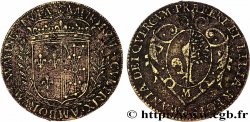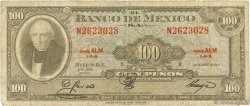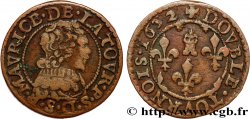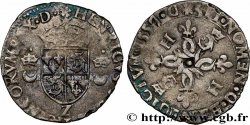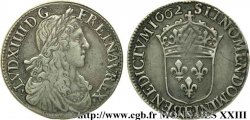E-auction 114-61530 - fjt_07313 - ILE DE FRANCE - TOWNS AND GENTRY Claude Le Peletier, prévot des marchands de Paris 1676
You must signin and be an approved bidder to bid, LOGIN TO BID. Accounts are subject to approval and the approval process takes place within 48 hours. Do not wait until the day a sale closes to register. Clicking on « bid » constitutes acceptance of the terms of use of cgb.fr private e-auctions.
Bids must be placed in whole Euro amounts only. The sale will start closing at the time stated on the item description; any bids received at the site after the closing time will not be executed. Transmission times may vary and bids could be rejected if you wait until the last second. For further information ckeck the E-auctions F.A.Q.
NO BUYER'S FEE.
NO BUYER'S FEE.
| Estimate : | 85 € |
| Price : | 24 € |
| Maximum bid : | 27 € |
| End of the sale : | 22 June 2015 18:28:30 |
| bidders : | 7 bidders |
Type : Claude Le Peletier, prévot des marchands de Paris
Date: 1676
Metal : silver
Diameter : 27 mm
Orientation dies : 12 h.
Edge : lisse
Rarity : R1
Catalogue references :
Obverse
Obverse legend : DE. LA. 4E. PREV. DE. MRE. CLAUDE. LE. PELETIER.
Obverse description : Armes de Paris.
Reverse
Reverse legend : RAMIS. FRONDESCIT. OLIVAE ; À L'EXERGUE : 1676.
Reverse description : La massue d'Hercule en pal.
Reverse translation : Elle se recouvre de feuilles d'olivier.
Commentary
D'Affry de la Monnoye donne l'explication du revers Pausanias raconte qu'à Trézène, Hercule, ayant posé sa massue près du simulacre d'Hermès, cette massue d'olivier sauvage, prit racine et poussa aussitôt des feuilles Les victoires de Louis XIV sont comparées à cette massue et ont pour conséquence la paix, symbolisée par l'olivier.
Claude Le Peletier, seigneur d’Ablon, de Montmélian, de Morfontaine...., né en juin 1631, d’abord conseiller au Châtelet, il passa, le 29 janvier 1652, au Parlement, où il devint, en 1662, président de la cinquième chambre des enquêtes. Après la mort de Gaston, duc d’Orléans (2 février 1660), il fut tuteur des filles de ce prince. En 1667, il fut choisi pour doyen d’honneur de la Faculté de droit. Nommé conseiller d’État en 1673, il fut appelé, en 1683, après la mort de Colbert, au poste de contrôleur général des finances, qu’il occupa jusqu’en septembre 1689, et il fut, en outre, créé ministre d’État. En 1686, il acheta une charge de président à mortier, qu’il céda, trois ans après, à son fils Louis. Enfin, il fut chargé de la surintendance des postes en 1671, en remplacement du marquis de Louvois. Désirant le repos, il se démit de ses emplois en 1697, et il mourut, dans la retraite, le 10 août 1711, à quatre-vingt ans.
D'Affry de la Monnoye gives the explanation of the reverse Pausanias tells that at Troezen, Hercules, having placed his club near the simulacrum of Hermes, this wild olive club took root and immediately grew leaves The victories of Louis XIV are compared to this club and result in peace, symbolized by the olive tree.
Claude Le Peletier, Lord of Ablon, Montmélian, Morfontaine. . . . , born in June 1631, first councilor at the Châtelet, he moved, on January 29, 1652, to Parliament, where he became, in 1662, president of the fifth chamber of inquiries. After the death of Gaston, Duke of Orleans (February 2, 1660), he was tutor to the daughters of this prince. In 1667 he was chosen as honorary dean of the Faculty of Law. Appointed State Councilor in 1673, he was called, in 1683, after the death of Colbert, to the post of Comptroller General of Finances, which he occupied until September 1689, and he was, in addition, created Minister of State. In 1686, he bought a position as president of the mortar board, which he gave, three years later, to his son Louis. Finally, he was put in charge of the superintendence of the posts in 1671, replacing the Marquis de Louvois. Desiring rest, he resigned from his employment in 1697, and he died in retirement on August 10, 1711, at the age of eighty.
Claude Le Peletier, seigneur d’Ablon, de Montmélian, de Morfontaine...., né en juin 1631, d’abord conseiller au Châtelet, il passa, le 29 janvier 1652, au Parlement, où il devint, en 1662, président de la cinquième chambre des enquêtes. Après la mort de Gaston, duc d’Orléans (2 février 1660), il fut tuteur des filles de ce prince. En 1667, il fut choisi pour doyen d’honneur de la Faculté de droit. Nommé conseiller d’État en 1673, il fut appelé, en 1683, après la mort de Colbert, au poste de contrôleur général des finances, qu’il occupa jusqu’en septembre 1689, et il fut, en outre, créé ministre d’État. En 1686, il acheta une charge de président à mortier, qu’il céda, trois ans après, à son fils Louis. Enfin, il fut chargé de la surintendance des postes en 1671, en remplacement du marquis de Louvois. Désirant le repos, il se démit de ses emplois en 1697, et il mourut, dans la retraite, le 10 août 1711, à quatre-vingt ans.
D'Affry de la Monnoye gives the explanation of the reverse Pausanias tells that at Troezen, Hercules, having placed his club near the simulacrum of Hermes, this wild olive club took root and immediately grew leaves The victories of Louis XIV are compared to this club and result in peace, symbolized by the olive tree.
Claude Le Peletier, Lord of Ablon, Montmélian, Morfontaine. . . . , born in June 1631, first councilor at the Châtelet, he moved, on January 29, 1652, to Parliament, where he became, in 1662, president of the fifth chamber of inquiries. After the death of Gaston, Duke of Orleans (February 2, 1660), he was tutor to the daughters of this prince. In 1667 he was chosen as honorary dean of the Faculty of Law. Appointed State Councilor in 1673, he was called, in 1683, after the death of Colbert, to the post of Comptroller General of Finances, which he occupied until September 1689, and he was, in addition, created Minister of State. In 1686, he bought a position as president of the mortar board, which he gave, three years later, to his son Louis. Finally, he was put in charge of the superintendence of the posts in 1671, replacing the Marquis de Louvois. Desiring rest, he resigned from his employment in 1697, and he died in retirement on August 10, 1711, at the age of eighty.








 Report a mistake
Report a mistake Print the page
Print the page Share my selection
Share my selection Ask a question
Ask a question Consign / sell
Consign / sell
 Full data
Full data



